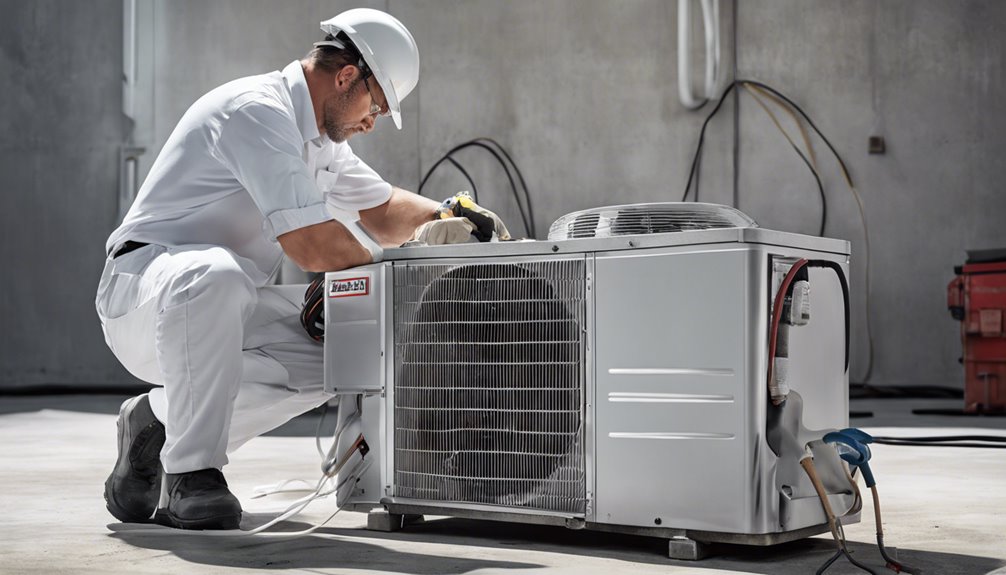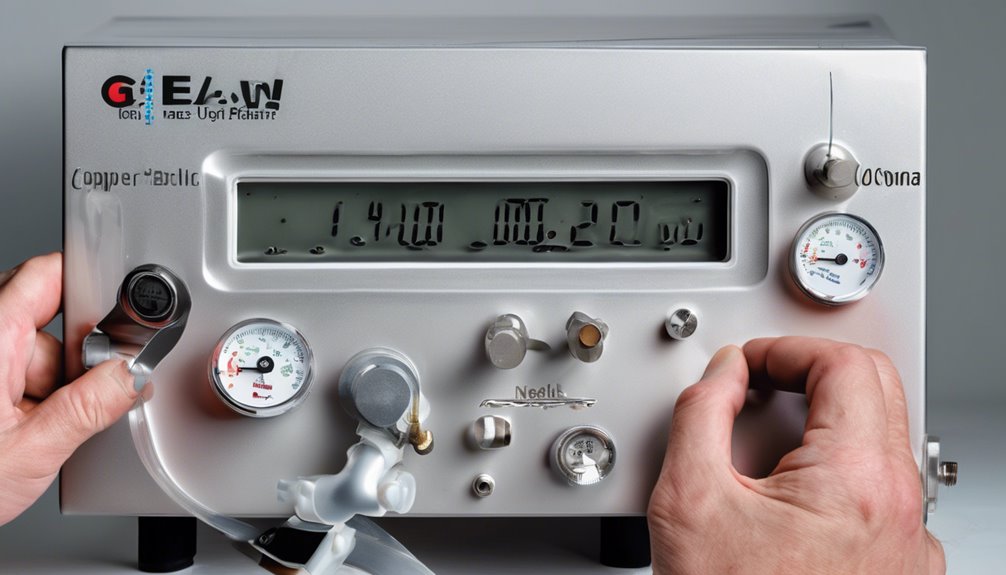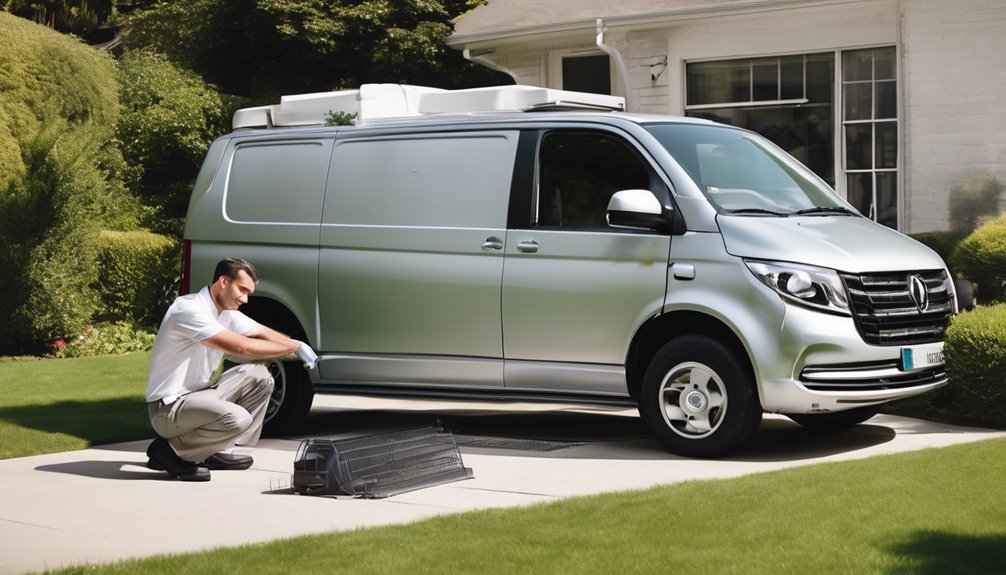To ensure a smooth and efficient residential air conditioning installation, start by assessing your cooling needs and choosing the right AC unit for your home. Proper sizing is crucial, so perform a load calculation to get it just right. Select a qualified installer and prepare your home for installation by clearing the space and checking window options. Install a programmable thermostat and consider advanced features like scheduling and remote control capabilities. Finally, plan for regular maintenance and verify the warranty and support package – and that's just the beginning of your journey to optimal comfort and energy efficiency.
Key Takeaways
- Determine your home's unique characteristics, including size, windows, and insulation, to choose the right AC unit and ensure proper sizing.
- Ensure a qualified installer is hired, looking for certifications like NATE or R-410A, and check local referrals and online reviews.
- Inspect and prepare your home for installation by clearing the space, checking window options, and sealing any air leaks in ducts.
- Install a programmable thermostat to regulate temperature and ensure energy efficiency, and consider additional features like smart home integration.
- Create a maintenance schedule to ensure regular check-ups and prevent breakdowns, including checking and replacing air filters every 1-3 months.
Assess Your Cooling Needs
Determine how much cooling power you need by assessing your home's unique characteristics.
Consider factors like your home's size, number of windows, insulation, and local climate. A larger home with many windows will require more cooling capacity than a smaller, well-insulated one.
You should also think about your energy efficiency goals.
Do you want to reduce your energy bills and carbon footprint? If so, look for a system with a high energy efficiency rating. This won't only help the environment but also save you money in the long run.
Choose the Right AC Unit
Now that you've assessed your cooling needs, it's time to select the right air conditioning unit for your home.
You'll want to consider factors beyond just the initial cost of the unit, such as energy efficiency and long-term savings. Look for units with high Seasonal Energy Efficiency Ratings (SEER) and Energy Star certification.
- Imagine a unit that learns your schedule and preferences to optimize cooling and energy use.
- Picture a system that can be controlled remotely, so you can adjust the temperature from anywhere.
- Envision a unit that provides real-time energy usage reports, helping you identify areas for improvement.
Ensure Proper Sizing
You've selected the right air conditioning unit for your home, but its performance largely depends on its size.
A unit that's too small won't cool your home efficiently, while one that's too large will waste energy and increase your bills.
To ensure proper sizing, you need to perform a load calculation.
This involves calculating the total heat gain in your home, taking into account factors like insulation, window size, and local climate.
You can do a manual calculation or use software to get an accurate estimate.
Don't rely on rules of thumb or guesswork, as this can lead to incorrect sizing.
Select a Qualified Installer
With your properly sized air conditioning unit in hand, it's crucial to find a qualified installer to ensure a seamless and efficient installation process.
You want someone who can handle the job correctly, so your air conditioner runs smoothly and efficiently for years to come.
- Look for installer certification from organizations like NATE (North American Technician Excellence) or R-410A, which ensure they've the necessary skills and knowledge.
- Ask for local referrals from friends, family, or neighbors who've had a good experience with an installer.
- Check online reviews and ratings to get an idea of the installer's reputation and level of customer satisfaction.
Prepare Your Home for Installation
You'll want to prepare your home for the installation process by clearing the space around the installation area, checking your window options to ensure a proper fit, and planning for ductwork that meets your home's unique needs.
This preparation will help the installation process go smoothly and efficiently. By taking these steps, you'll be ready for a successful and stress-free installation.
Clear the Space
Before the installation team arrives, clear the space around your new air conditioning unit to ensure a smooth and efficient process.
You want to give them a clear path to work on, so remove any obstacles that might get in their way. This will help them complete the installation quickly and correctly.
- Move any furniture or decorations away from the installation area
- Clear clutter from the floor, such as shoes or toys
- Take down any curtains or blinds that may be obstructing the area
Check Window Options
Now that the installation area is clear, consider the window options for your residential air conditioning installation.
You'll want to ensure the window type you choose can accommodate the AC unit and allow for proper airflow. For instance, casement windows or sliding windows might be more suitable than double-hung windows.
Additionally, inspect the window seals to ensure they're tight and won't let warm air escape or cold air in. Loose or damaged seals can reduce the AC's efficiency and drive up your energy bills.
Take the time to assess your window options and make any necessary adjustments before the installation begins. This will help ensure a smooth and successful installation process.
Plan for Ductwork
The layout of your home's ductwork plays a crucial role in the success of your residential air conditioning installation.
You'll want to ensure it's designed and installed correctly to optimize airflow and efficiency.
When planning your ductwork, consider the following:
- Flexible duct material that can be easily maneuvered through tight spaces, such as attics or crawl spaces
- Strategic vent placement to distribute cooled air evenly throughout your home
- Sealed joints and connections to prevent energy loss and moisture buildup
Inspect and Upgrade Ductwork
You're about to breathe new life into your residential air conditioning system, and it starts with inspecting and upgrading your ductwork.
Begin by inspecting your ducts for air leaks, which can significantly reduce your system's efficiency.
Check for gaps, cracks, and loose connections, sealing them with mastic sealant or foil tape.
Next, assess your duct material – if it's old, damaged, or corroded, consider replacing it with newer, more durable material.
Upgrading your ductwork will ensure that your new air conditioning system operates efficiently and effectively.
Install a Programmable Thermostat
With your ductwork inspected and upgraded, it's time to focus on installing a programmable thermostat, a crucial component of your residential air conditioning system.
This device allows you to regulate the temperature in your home with precision, ensuring energy efficiency and temperature consistency.
- Imagine waking up to a cool and comfortable home on a hot summer morning, without having to worry about cranking up the AC all night.
- Picture yourself coming home from work to a refreshing atmosphere, without having to adjust the thermostat every hour.
- Envision saving money on your energy bills, thanks to the thermostat's automated temperature adjustments.
Consider Additional Features
Smart home integration, zoning capabilities, and advanced humidity control are just a few additional features you may want to consider when selecting a programmable thermostat.
These features can take your residential air conditioning installation to the next level. For instance, smart integration allows you to control your AC remotely using your smartphone, ensuring you can adjust the temperature even when you're not at home.
Additionally, consider air purification features that can improve indoor air quality. This is especially important for households with allergy sufferers or pets.
Plan for Regular Maintenance
Regularly scheduling maintenance for your residential air conditioning installation is crucial to ensure it runs efficiently and effectively throughout the year.
You'll want to create a maintenance schedule that includes routine check-ups to prevent unexpected breakdowns. This will save you time, money, and stress in the long run.
- Check and replace your air filter every 1-3 months to improve air quality and system performance.
- Inspect and clean your outdoor unit regularly to ensure proper airflow and prevent damage.
- Schedule professional tune-ups annually to identify and fix potential issues before they become major problems.
Verify Warranty and Support
Your residential air conditioning installation comes with a warranty and support package that can provide you with peace of mind and protection for your investment. Before finalizing your installation, make sure you understand the terms and conditions of the warranty and support package. Review the manufacturer's commitments to ensure you're getting the coverage you need.
| Warranty Aspect | What to Expect |
|---|---|
| Standard Coverage | Typically 1-5 years, covering parts and labor for repairs and replacements |
| Extended Coverage | Optional, additional years of coverage for added peace of mind |
| Manufacturer Support | Dedicated customer service, online resources, and troubleshooting guidance |
| Service Provider Support | Ongoing maintenance, repair, and replacement services from the installation company |
Frequently Asked Questions
What Is the Average Lifespan of a Residential Air Conditioning Unit?
You can expect your residential air conditioning unit to last around 10-15 years, but with regular unit maintenance and a focus on energy efficiency, you might get up to 20 years of cool comfort from your AC.
Can I Install an AC Unit Myself to Save Money?
You're tempted to install an AC unit yourself to save money, but beware: DIY mistakes can lead to costly repairs, and you'll assume personal liability for any damage or injuries, making it a risky gamble.
How Often Should I Clean My Air Conditioning Filters?
You should clean your air conditioning filters every 1-2 months to maintain filter efficiency and prevent dusty coils, which can increase energy bills and reduce airflow, making your AC work harder and longer.
Will a New AC Unit Increase My Home's Value?
When you install a new AC unit, you'll not only enjoy a cooler home, but you'll also increase its resale value, thanks to the boost in energy efficiency, making your home more attractive to potential buyers.
Can I Use a Portable AC Unit Instead of a Central AC System?
You're considering a portable AC unit, but it might not be the best fit, especially if you're dealing with space constraints. Portable units can be less energy efficient and may not cool your entire home as effectively as a central AC system would.
Conclusion
You've made it! You're now well-equipped to tackle your residential air conditioning installation project. By following these 10 essential tips, you'll ensure a smooth, hassle-free experience. Remember, a properly installed AC unit will provide you with years of comfortable cooling, energy efficiency, and cost savings. So, take a deep breath, stay cool, and enjoy your newly installed air conditioning system!



